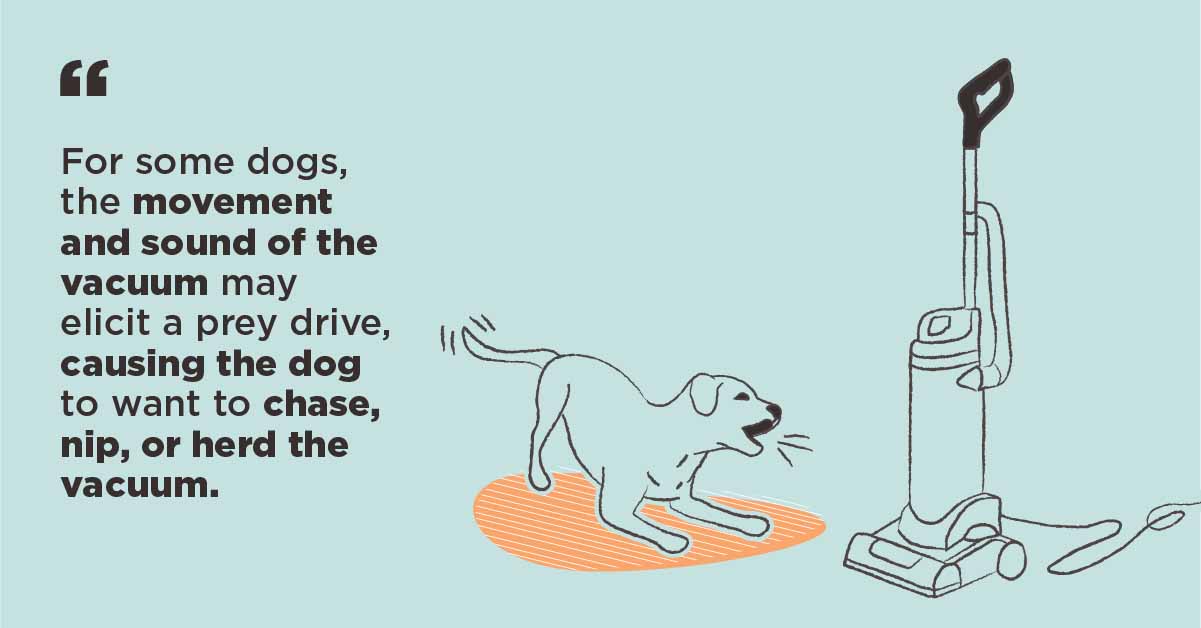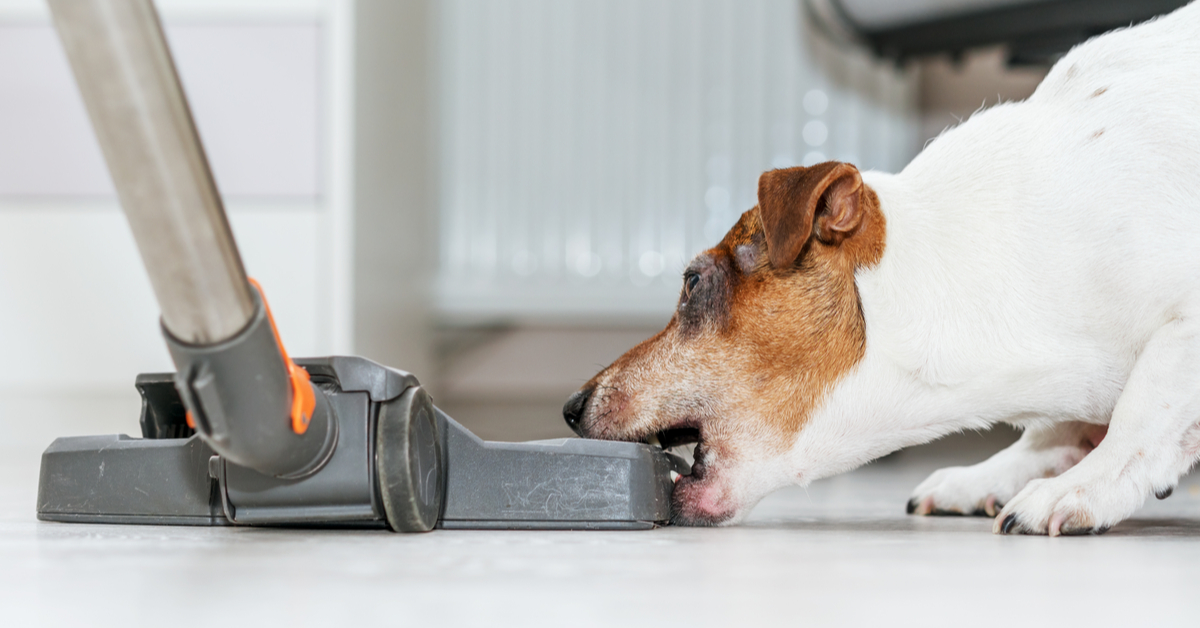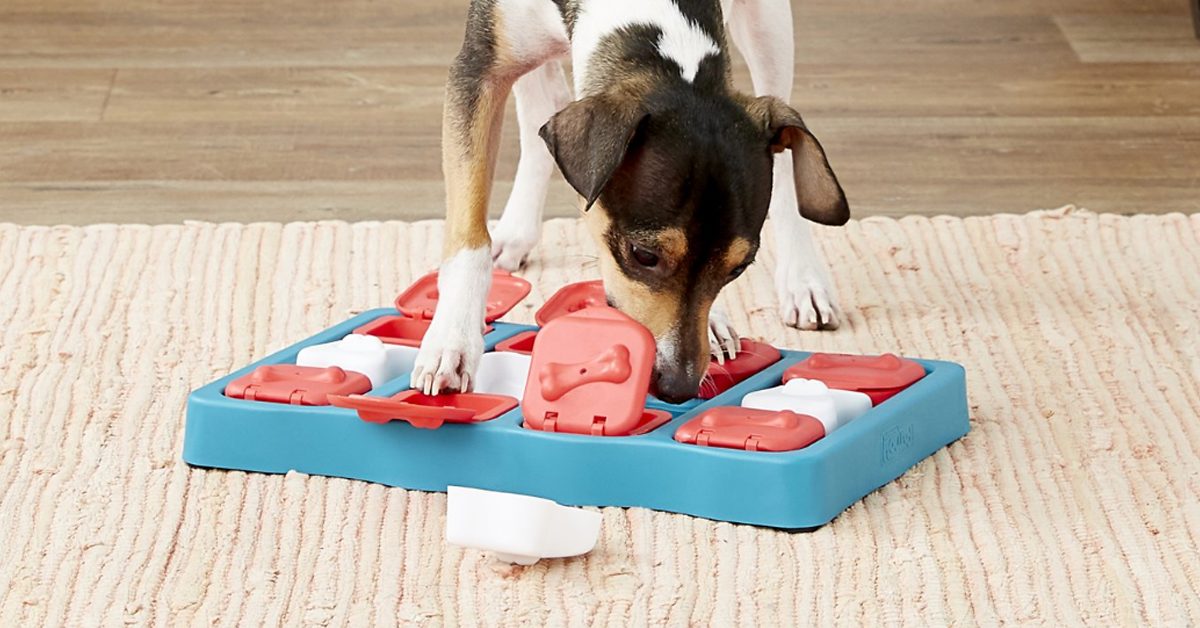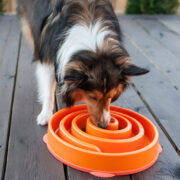Why Do Dogs Hate Vacuums So Much?
We all need to keep our homes clean, but unfortunately a lot of dogs have negative feelings about vacuum cleaners. As a pet parent you might wonder, why do dogs hate vacuums, anyway?
While humans understand vacuums are harmless, for many dogs they are loud, intimidating and threatening. In response dogs may react to the vacuum’s loud noises in ways that are overwhelming or frustrating to us like barking, lunging, or even hiding.
Why Is My Dog Afraid of Vacuums?

Vacuums are loud and that sound is unpleasant or even painful for our dogs. If the vacuum seems noisy to us, dogs — whose hearing is significantly better than our own — are going to experience that vacuuming noise as even more disruptive and unpleasant.
In addition to their superior sense of smell, dogs can hear sound frequencies at least three times as high compared to the human ear. Just like with thunderstorms, many dogs’ fear of vacuums stems from the loud, high-frequency noises the machine makes.
Dogs who are already sound sensitive or nervous may be particularly predisposed to discomfort around the vacuum being used in the home. Some dogs might perceive vacuums as something to herd, or a possibly dangerous intruder, while others may have had a negative experience with the vacuum in the past which contributes to that dog’s fear.
Dog owners should never tease or chase their dog with the vacuum, or allow their children to taunt the dog with the vacuum. This will only make your dogs afraid even more and hinder desensitization efforts later on.
Challenging Vacuum Behavior
When vacuums are used many dogs go into a fight or flight response. For some dogs, this will look like running away and hiding anytime the vacuum comes out to try to escape it in another part of the house. Other dogs will attempt to attack, lunge, bark or bite at the vacuum. Both of these responses are generally rooted in fear, so they will try to get away from the vacuum or scare it away, afraid it will hurt them.
Other dogs may perceive the vacuum as a threat and attempt to protect you from it, which can lead to your dog lunging or barking at the vacuum. For other dogs, the movement and sound of the vacuum may elicit a herding or prey drive, causing the dog to want to chase, nip, or herd the vacuum. This can result in your dog breaking the vacuum, puncturing the hoses.
Additionally, your dog is becoming increasingly aroused and/or stressed by the presence of the vacuum, leading to the unwanted behavior worsening over time.
Counterconditioning and Desensitization

It’s important not to scold or punish your dog for their reactions to the vacuum. Instead, we want to use positive reinforcement training approaches to help our dogs develop new reactions to the presence of the vacuum. Counterconditioning and desensitizing are training techniques that will help your dog shift their relationships to something they initially are uncertain or uncomfortable about.
In order to counter-condition the dog to the vacuum, you don’t want to force them to be close to something they find upsetting. Instead, to help our dogs we want to work at a distance where they feel comfortable. Then, let them work at their own pace, however fast or slow that is to recognize that the vacuum isn’t going to cause them harm.
We do this by pairing the presence of the vacuum (again at whatever distance is comfortable to your dog) with something positive like high-value treats and praise. Over time your dog will begin to associate the presence of the vacuum with the reward, which in turn will shift your dog’s overall feelings about the vacuum.
Introducing Your Dog to Vacuum Cleaners
Be intentional about exposing your dog to the vacuum. If you have a puppy, start them at a young age. When introducing your dog to the vacuum it can be helpful to have a friend or family member help by either working with your dog or doing the vacuuming. This will help prevent challenges in the future and help your dog to build new positive relationships with the vacuum.
Step 1: Vacuum Off
Bring the vacuum out but do not turn it on. Allow your dog to explore the vacuum but do not pull or otherwise force your dog to get close to it. Praise and reward with treats when your dog starts to show any interest or explores the vacuum, starting with just looking at it from across the room.
Step 2: Moving the Vacuum
Next we want to get our dogs used to the idea that the vacuum can move. Start moving the vacuum without it turned on, and pair the movement with giving your dog treats from a distance where they are comfortable. For some dogs this will be across the house or apartment. For others it might be just in another part of the room. Praise and reward your dog.
Step 3: Vacuum On
When your dog is comfortable with the vacuum being pushed around turned off, it’s time to turn the vacuum on. Make sure your dog is distanced from the vacuum to start with and have lots of treats ready. When the vacuum gets turned on, praise your dog and offer treats anytime your dog calmly glances towards the background.
Keep your training sessions with the vacuum short, fun and upbeat with lots of praise and treats.
Have Patience

You want to work at your dog’s pace to build comfort around the vacuum cleaner. If your dog gets overwhelmed and starts to react by barking, running, lunging or any of the stress-related unwanted behaviors we are trying to avoid, it means we have pushed too hard and need to take a break.
Go back to a distance that your dog is comfortable and able to be successful during your next training session. If you are having trouble with this, you can always enlist the help of a dog trainer.
What About Robot Vacuums?
Pet owners are increasingly adding robotic vacuums that can be programmed to independently vacuum their home. These can be a great way to keep pet hair from accumulating around the house, but the movement of the vacuum will be a bit more unpredictable as the robot will be working on its own. This means it could potentially bump into your dog if they don’t move out of the way. An autonomous moving object like that could make your dog feel pretty scared.
For that reason, it’s best to supervise your dog whenever the robot is running. Introducing your dog to the robot vacuum for the first time starts the same way as you would any other vacuum: by giving your dog the chance to investigate it with the vacuum turned off.
Praise and reward any interactions with the vacuum. It can also be helpful to let your dog calmly watch the vacuum and call your dog before it goes near them to help your dog understand they need to move out of the way.
It’s OK to Take a Training Break!

Sometimes we just need to vacuum and don’t have the time and capacity to both clean and train with our dog. If you aren’t able to focus on training, set your pooch up for success by putting them safely in another area of your home away from the vacuum.
Try giving your dog a safe chew or a puzzle toy stuffed with peanut butter or dog treats. This will not only give your dog something rewarding to distract and mentally occupy them, but it will also help your dog to build positive associations to the distant sound of vacuuming taking place without your dog rehearsing more of the unwanted behavior.
Alternately, you can have someone else take the dog out for a walk. It’s OK to not always have the capacity to support your dog through a challenging training session. If you know that your dog is already having a rough time, give them the opportunity to be successful by not having to even engage with the vacuum that day.
Demystifying certain dog behaviors starts with interpreting their body language. Check out our comprehensive guide on how to speak dog.

